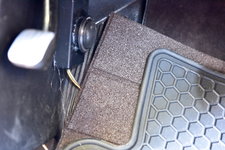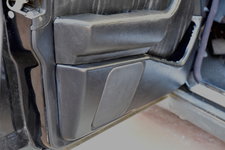This distributor business is having new twists, never boring. Today, I wanted to put the new replacement distributor on the car and took down the old distributor. After I pulled the car out of garage, suddenly, I saw a little mouse jumped off from the front bumper. First time, I noticed a mouse in my garage (may be I have been so oblivious) and I absolutely hate it. What does this disgusting thing need or want from a car?
Because I was so disgusted, I wanted to drive the car to heat up the engine area to ensure this thing is not inside anymore. I drove to a local Walmart, about 1.5 miles away, to get some baits to get rid of them, risking my life due to potential Chinese virus exposure.
When I came out, in less than 10 minute, the car won't start. I tried a few times. It cranked but won't start. I figured that the distributor was having issues again. So, I walked home to drive my old green E320, with full set of tools and the new distributor. It was a nice walk, in the sun, to have my daily walk done in an unusual fashion.
Got back to the 1992 300E after about 25 minutes. Before working on the car, I decided to try again. It started right away. I guess that the car cooled down a bit. Drove it back and decided to take out the distributor to find out what could have happened.
Nothing in particular. The distributor looks fine. However, the new rotor, BERU, looked quite bad, in particular the three bolts. They had this corroded look with a white layer. I looked the old Bosch I replaced, it looks fine. I then realized that the BERU used aluminum bolts. However, the rotor bracket, which is bolted to the camshaft, is made of brass. As a result, there is galvanic effect. I really don't like what I saw and decided to take off the BERU rotor. The bolts became very tight due to the galvanic corrosion. I was able to remove two of them but the third one was rounded (these damn allen bolts). My bolt extractors do not have the right size to remove it. So, I used a plier to remove it. Bad idea. I broke the rotor and one leg of the rotor bracket.
So, the problem just got worse. To remove the rotor bracket (Mercedes Distributor Rotor Bracket (M103) - Genuine Mercedes 1031580840), I used a T30 tool to loosen the center bolt. The bolt was removed without issues. However, the rotor bracket is tapered fit to the camshaft and it won't come out. Checked out a few youtube videos and they all had the same struggles and some broke the piece when removing it. Finally, one suggestion was to tap the center hole with M8x1.25 and pull it out with a bolt. I was able to do this by my oil filter socket and a M8 bolt as a pulling tool. It worked beautifully.
Went to FCP EURO and order a new rotor bracket and a new rotor (under the lifetime replacement).
Then I started to think why the first BERU failed. The center graphite pin contact broke and the center support tube melted. It was overheated, apparently. Why the car failed to start today? And then it started after sitting for about 30 minutes.
After removing the rotor bracket, the back cover of the distributor was removed too. There is no leak through the camshaft seal. Therefore, I don't change the seal even though I ordered one along with a time chain cover seal.
So, the question: Why it overheated at the center pin contact and the rotor? Could it because of lack of contact? I tried to fit the back cover and the distributor together. Then, I realized the potential issue.
I also replaced the distributor O-ring, ordered from FCP. This O-ring is slightly oversized and it is quite thick. As a result, the back cover and the distributor do not fit together as close as necessary. The center connector pin of the distributor probably barely touched the rotor center. This poor contact might be the reason for the overheating problem.
Once the new parts arrive, I will measure the fit condition between the center pin and the rotor. If the fit is poor, I will use silicon for seal instead of the oversized O-ring.
jftu105
Because I was so disgusted, I wanted to drive the car to heat up the engine area to ensure this thing is not inside anymore. I drove to a local Walmart, about 1.5 miles away, to get some baits to get rid of them, risking my life due to potential Chinese virus exposure.
When I came out, in less than 10 minute, the car won't start. I tried a few times. It cranked but won't start. I figured that the distributor was having issues again. So, I walked home to drive my old green E320, with full set of tools and the new distributor. It was a nice walk, in the sun, to have my daily walk done in an unusual fashion.
Got back to the 1992 300E after about 25 minutes. Before working on the car, I decided to try again. It started right away. I guess that the car cooled down a bit. Drove it back and decided to take out the distributor to find out what could have happened.
Nothing in particular. The distributor looks fine. However, the new rotor, BERU, looked quite bad, in particular the three bolts. They had this corroded look with a white layer. I looked the old Bosch I replaced, it looks fine. I then realized that the BERU used aluminum bolts. However, the rotor bracket, which is bolted to the camshaft, is made of brass. As a result, there is galvanic effect. I really don't like what I saw and decided to take off the BERU rotor. The bolts became very tight due to the galvanic corrosion. I was able to remove two of them but the third one was rounded (these damn allen bolts). My bolt extractors do not have the right size to remove it. So, I used a plier to remove it. Bad idea. I broke the rotor and one leg of the rotor bracket.
So, the problem just got worse. To remove the rotor bracket (Mercedes Distributor Rotor Bracket (M103) - Genuine Mercedes 1031580840), I used a T30 tool to loosen the center bolt. The bolt was removed without issues. However, the rotor bracket is tapered fit to the camshaft and it won't come out. Checked out a few youtube videos and they all had the same struggles and some broke the piece when removing it. Finally, one suggestion was to tap the center hole with M8x1.25 and pull it out with a bolt. I was able to do this by my oil filter socket and a M8 bolt as a pulling tool. It worked beautifully.
Went to FCP EURO and order a new rotor bracket and a new rotor (under the lifetime replacement).
Then I started to think why the first BERU failed. The center graphite pin contact broke and the center support tube melted. It was overheated, apparently. Why the car failed to start today? And then it started after sitting for about 30 minutes.
After removing the rotor bracket, the back cover of the distributor was removed too. There is no leak through the camshaft seal. Therefore, I don't change the seal even though I ordered one along with a time chain cover seal.
So, the question: Why it overheated at the center pin contact and the rotor? Could it because of lack of contact? I tried to fit the back cover and the distributor together. Then, I realized the potential issue.
I also replaced the distributor O-ring, ordered from FCP. This O-ring is slightly oversized and it is quite thick. As a result, the back cover and the distributor do not fit together as close as necessary. The center connector pin of the distributor probably barely touched the rotor center. This poor contact might be the reason for the overheating problem.
Once the new parts arrive, I will measure the fit condition between the center pin and the rotor. If the fit is poor, I will use silicon for seal instead of the oversized O-ring.
jftu105

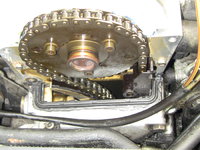

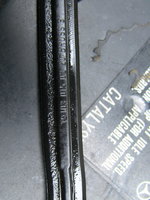


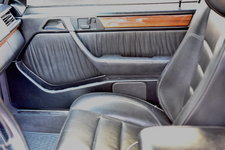
![[500Eboard] IMG_3843.JPG](/forums/data/attachments/122/122622-cf6a6723834bb37d2dc6032a280c58cd.jpg?hash=z2pnI4NLs3)
